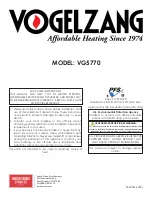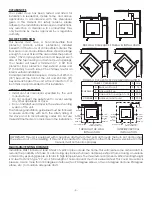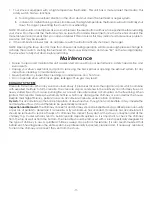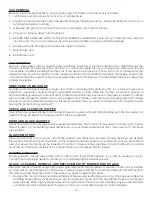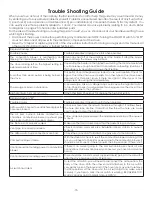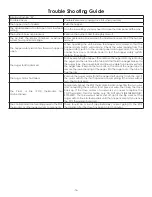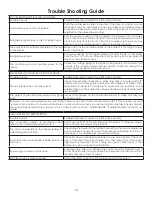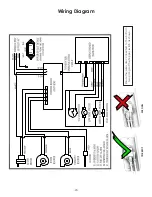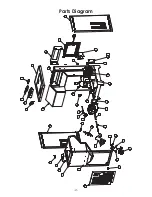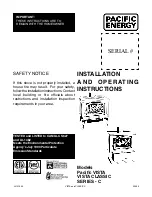
-
6
-
THROUGH THE WALL INSTALLATION
(RECOMMENDED INSTALLATION)
Canadian installations must conform to CAN/
CSA-B365. To vent the unit through the wall, connect
the pipe adapter to the exhaust motor adapter. If
the exhaust adapter is at least 18” (457mm) above
ground level, a straight section of pellet vent pipe can
be used through the wall. Your heater dealer should
be able to provide you with a kit that will handle
most of this installation, which will include a wall
thimble that will allow the proper clearance through
a combustible wall. Once outside the structure, a 3”
(76mm) clearance should be maintained from the
outside wall and a clean out tee should be placed
on the pipe with a 90-degree turn away from the
house. At this point, a 3ft (0.91m) (minimum) section
of pipe should be added with a horizontal cap,
which would complete the installation. A support
bracket should be placed just below the termination
cap or one every 4ft (1.22m) to make the system
more stable. If you live in an area that has heavy
snowfall, it is recommended that the installation be
taller than 3ft (0.91m) to get above the snowdrift line.
This same installation can be used if your heater is
below ground level by simply adding the clean-out
section and vertical pipe inside until ground level is
reached. With this installation you have to be aware
of the snowdrift line, dead grass, and leaves. We
recommend a 3ft (0.91m) minimum vertical rise on
the inside or outside of the house. The “through the
wall” installation is the least expensive and simplest
installation. Never terminate the end vent under a
deck, in an alcove, under a window, or between
two windows. We recommend Simpson Dura-Vent®
or Metal-Fab® kits.
ATTENTION: DO NOT vent under any porch, deck, awning, or in any semi enclosed or roofed area. Doing so
may result in unpredictable airflow at the vent cap under certain conditions and can affect the performance
of your stove, as well as, other unforeseeable issues.
69FAK OUTSIDE AIR SUPPLY
(OPTIONAL, UNLESS INSTALLING IN A MOBILE HOME)
Depending on your location and home construction, outside air may be necessary for optimal performance.
1. With the stove in the operating position, mark and drill a hole to accommodate the 2” flexible hose.
2.
Insert the hose through the wall and attach the Outside Cover with one of the 2” hose clamps provided.
3.
Then attach the Outside Cover to the outside wall.
4.
Next, attach the Rodent Cover to the Outside Cover using four (4) of the #10 x 3/4 screws supplied.
5.
On the inside of the home, slide the Inside Plate over the tube then attach to the wall with the four drywall
anchors and screws provided.
TYPICAL THROUGH THE
WALL INSTALLATION
THROUGH THE ROOF/CEILING INSTALLATION
When venting the heater through the ceiling, the pipe is connected the same as through the wall, except the
clean-out tee is always on the inside of the house, and a 3” (76mm) adapter is added before the clean-out tee.
You must use the proper ceiling support flanges and roof flashing (supplied by the pipe manufacturer; follow the
pipe manufacturer’s directions). It is important to note that if your vertical run of pipe is more than 12ft (3.7m),
the pellet vent pipe size should be increased to 4” (102mm) in diameter. Do not exceed more than 4ft (1.22m) of
pipe on a horizontal run and use as few elbows as possible. If an offset is required, it is better to install 45-degree
elbows rather than 90-degree elbows.

